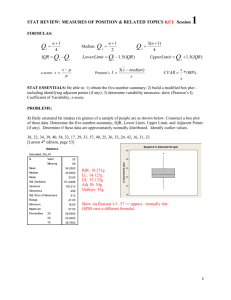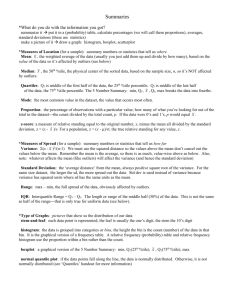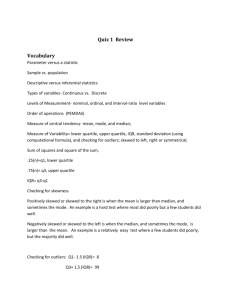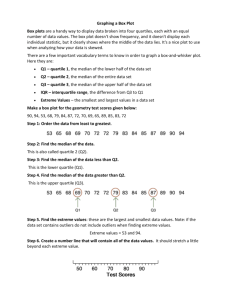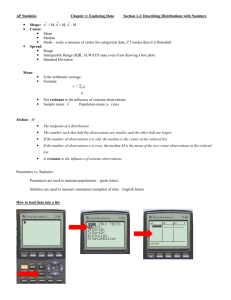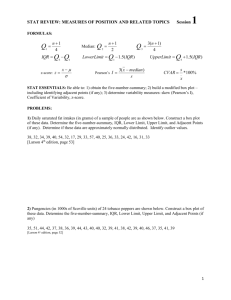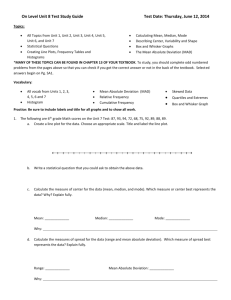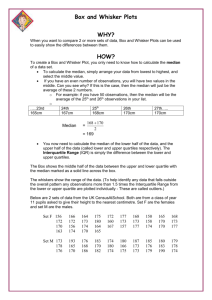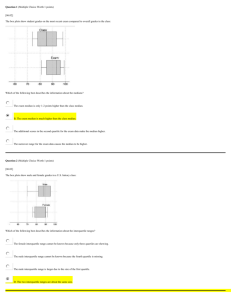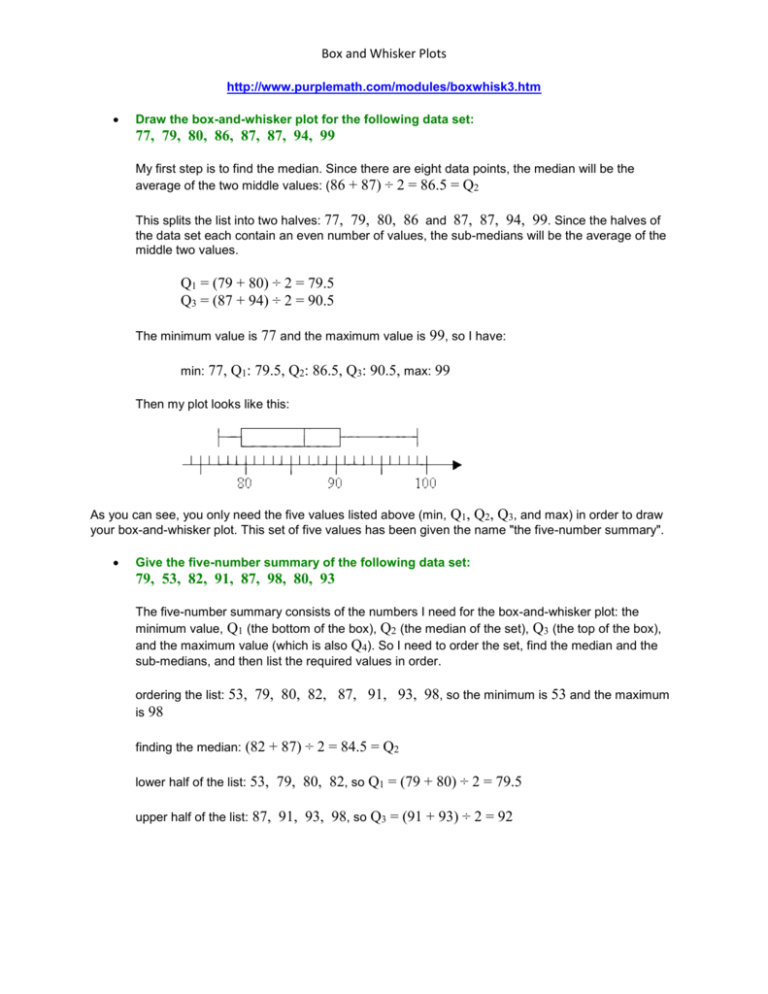
Box and Whisker Plots
http://www.purplemath.com/modules/boxwhisk3.htm
Draw the box-and-whisker plot for the following data set:
77, 79, 80, 86, 87, 87, 94, 99
My first step is to find the median. Since there are eight data points, the median will be the
average of the two middle values: (86 + 87) ÷ 2 = 86.5 = Q2
This splits the list into two halves: 77, 79, 80, 86 and 87, 87, 94, 99. Since the halves of
the data set each contain an even number of values, the sub-medians will be the average of the
middle two values.
Q1 = (79 + 80) ÷ 2 = 79.5
Q3 = (87 + 94) ÷ 2 = 90.5
The minimum value is
min: 77,
77 and the maximum value is 99, so I have:
Q1: 79.5, Q2: 86.5, Q3: 90.5, max: 99
Then my plot looks like this:
As you can see, you only need the five values listed above (min, Q1, Q2, Q3, and max) in order to draw
your box-and-whisker plot. This set of five values has been given the name "the five-number summary".
Give the five-number summary of the following data set:
79, 53, 82, 91, 87, 98, 80, 93
The five-number summary consists of the numbers I need for the box-and-whisker plot: the
minimum value, Q1 (the bottom of the box), Q2 (the median of the set), Q3 (the top of the box),
and the maximum value (which is also Q4). So I need to order the set, find the median and the
sub-medians, and then list the required values in order.
ordering the list:
is 98
53, 79, 80, 82, 87, 91, 93, 98, so the minimum is 53 and the maximum
finding the median:
(82 + 87) ÷ 2 = 84.5 = Q2
lower half of the list:
53, 79, 80, 82, so Q1 = (79 + 80) ÷ 2 = 79.5
upper half of the list:
87, 91, 93, 98, so Q3 = (91 + 93) ÷ 2 = 92
53, 79.5, 84.5, 92, 98
five-number summary:
Part of the point of a box-and-whisker plot is to show how spread out your values are. But what if one or
another of your values is way out of line? For this, we need to consider "outliers"....
The "interquartile range", abbreviated "IQR", is just the width of the box in the box-and-whisker plot. That
is, IQR = Q3 – Q1. The IQR can be used as a measure of how spread-out the values are. Statistics
assumes that your values are clustered around some central value. The IQR tells how spread out the
"middle" values are; it can also be used to tell when some of the other values are "too far" from the central
value. These "too far away" points are called "outliers", because they "lie outside" the range in which we
expect them.
The IQR is the length of the box in your box-and-whisker plot. An outlier is any value that lies more than
one and a half times the length of the box from either end of the box. That is, if a data point is below Q1 –
1.5×IQR or above Q3 + 1.5×IQR, it is viewed as being too far from the central values to be
reasonable. Maybe you bumped the weigh-scale when you were making that one measurement, or
maybe your lab partner is an idiot and you should never have let him touch any of the equipment. Who
knows? But whatever their cause, the outliers are those points that don't seem to "fit".
(Why one and a half times the width of the box? Why does that particular value demark the difference
between "acceptable" and "unacceptable" values? Because, when John Tukey was inventing the boxand-whisker plot in 1977 to display these values, he picked 1.5×IQR as the demarkation line for outliers.
This has worked well, so we've continued using that value ever since.)
Find the outliers, if any, for the following data set:
10.2, 14.1, 14.4. 14.4, 14.4, 14.5, 14.5, 14.6, 14.7,
14.7, 14.7, 14.9, 15.1, 15.9, 16.4
To find out if there are any outliers, I first have to find the IQR. There are fifteen data points, so
the median will be at position (15 + 1) ÷ 2 = 8. Then Q2 = 14.6. There are seven data points on
either side of the median, so Q1 is the fourth value in the list and Q3 is the twelfth: Q1 = 14.4 and
Q3 = 14.9. Then IQR = 14.9 – 14.4 = 0.5.
Outliers will be any points below
Q1 – 1.5×IQR = 14.4 – 0.75 = 13.65 or above Q3 + 1.5×IQR
= 14.9 + 0.75 = 15.65.
Then the outliers are at
10.2, 15.9, and 16.4.
The values for Q1 – 1.5×IQR and Q3 + 1.5×IQR are the "fences" that mark off the "reasonable" values
from the outlier values. Outliers lie outside the fences.
If your assignment is having you consider outliers and "extreme values", then the values for Q1 –
1.5×IQR and Q3 + 1.5×IQR are the "inner" fences and the values for Q1 – 3×IQR and
Q3 + 3×IQR are the "outer" fences. The outliers (marked with asterisks or open dots) are between the
inner and outer fences, and the extreme values (marked with whichever symbol you didn't use for the
outliers) are outside the outer fences. Copyright © Elizabeth Stapel 1999-2009 All Rights Reserved
By the way, your book may refer to the value of "1.5×IQR" as being a "step". Then the outliers will be the
numbers that are between one and two steps from the hinges, and extreme value will be the numbers
that are more than two steps from the hinges.
Looking again at the previous example, the outer fences would be at 14.4 – 3×0.5 = 12.9 and 14.9 +
3×0.5 = 16.4. Since 16.4 is right on the upper outer fence, this would be considered to be only an
outlier, not an extreme value. But 10.2 is fully below the lower outer fence, so 10.2 would be an extreme
value.
Your graphing calculator may or may not indicate whether a
box-and-whisker plot includes outliers. For instance, the above
problem includes the points 10.2, 15.9, and 16.4 as outliers.
One setting on my graphing calculator gives the simple boxand-whisker plot which uses only the five-number summary, so
the furthest outliers are shown as being the endpoints of the
whiskers:
A different calculator setting gives the box-and-whisker plot
with the outliers specially marked (in this case, with a
simulation of an open dot), and the whiskers going only as far
as the highest and lowest values that aren't outliers:
Note that my calculator makes no distinction between outliers
and extreme values.
If you're using your graphing calculator to help with these plots, make sure you know which setting you're
supposed to be using and what the results mean, or the calculator may give you a perfectly correct but
"wrong" answer.
Find the outliers and extreme values, if any, for the following data set, and draw the boxand-whisker plot. Mark any outliers with an asterisk and any extreme values with an open
dot.
21, 23, 24, 25, 29, 33, 49
To find the outliers and extreme values, I first have to find the IQR. Since there are seven values
in the list, the median is the fourth value, so Q2 = 25. The first half of the list is 21, 23, 24, so Q1
= 23; the second half is 29, 33, 49, so Q3 = 33. Then IQR = 33 – 23 = 10.
The outliers will be any values below 23 – 1.5×10 = 23 – 15 = 8 or above 33 + 1.5×10 = 33
15 = 48. The extreme values will be those below 23 – 3×10 = 23 – 30 = –7 or above 33 +
3×10 = 33 + 30 = 63.
So I have an outlier at 49 but no extreme values, I won't have a top whisker because
also the highest non-outlier, and my plot looks like this:
Q3 is
+


